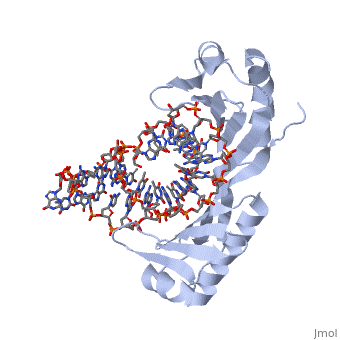Sandbox Reserved 469
From Proteopedia
| This Sandbox is Reserved from 13/03/2012, through 01/06/2012 for use in the course "Proteins and Molecular Mechanisms" taught by Robert B. Rose at the North Carolina State University, Raleigh, NC USA. This reservation includes Sandbox Reserved 451 through Sandbox Reserved 500. | ||||||
To get started:
More help: Help:Editing For more help, look at this link: http://www.proteopedia.org/wiki/index.php/Help:Getting_Started_in_Proteopedia
TATA Binding Protein (TBP)TBP (TATA Binding Protein) is a general transcription factor1. Along with several other transcription factors TBP serves as a guide for the docking of RNA Polymerase II1. TBP binds DNA at around 25-30 base pairs from the transcriptional start site in genes with promoters that contain a TATA box1. TBP is a component of the TF II B complex which along with several other general transcription factors makes up the preinitiation complex for RNA Polymerase II2. StructureTBP is a quite small single chain protein which has a saddle shape3. The concave portions of the protein which bind to DNA are highly conserved. By contrast, the upper portion of the “saddle” is much more variable from species to species. This is due to the fact that the upper part of TBP is not in contact with DNA, nor is it directly involved with the binding of DNA3. Unlike most proteins TBP binds DNA through the minor groove instead of the major groove. FunctionTBP plays a key role for the initiation of transcription in eukaryotic organisms. The function is not only to help target the sequence of DNA that is to be used for transcription as stated above, but TBP also functions to help initiate the transcription bubble. This is accomplished by bending the DNA to approximately an 80o angle which locally unwinds the DNA and is widely thought to be the method by which transcription is initiated3. When the DNA is locally unwound, RNA polymerases and other proteins are recruited to help stabilize the DNA3. This protein recruitment also initiates the beginning phases of transcription. Bending of The DNA has been determined to be a two step process. Step 1 is intercalation of DNA by a phenylalanine residue of the TBP. Intercalation occurs between the first and second base pairs at the 5’ end of the TATA box3. This creates the first intermediate of DNA bent at a 45o angle3. This TBP DNA complex is given added stability from the binding of TF II B3. Step number 2 is another phenylalanine residue intercalating the DNA between the last two base pairs at the 3’ end of the TATA box3. Again the intercalation bends the DNA another 45o and is then stabilized by TF II B3. Dissociation of TBP from DNA is an extremely long period of time when compared to other proteins with dissociation half times in vitro have been measured from 15 minutes to 1 hour and more4. There are 2 regulator proteins that have been found to have global effect of TBP, and these are Mot1 and NC24. Mot1 is an ATPase which uses an ATP hydrolysis to displace TBP from DNA4. NC2 functions as a heterodimer of TBP that prevents the formation of the preintiation complex by blocking TBP from binding DNA4. |

